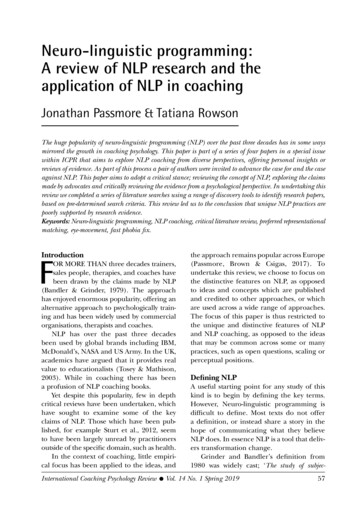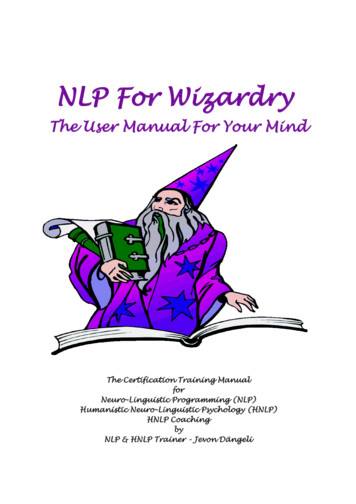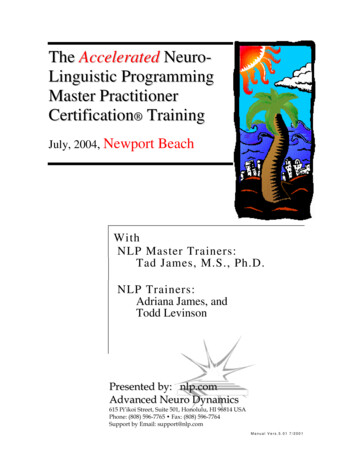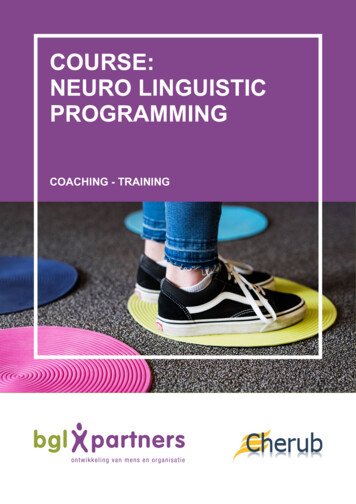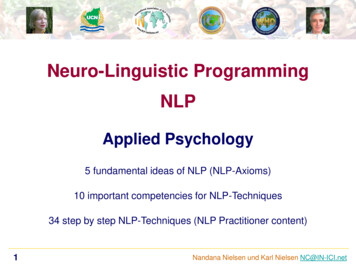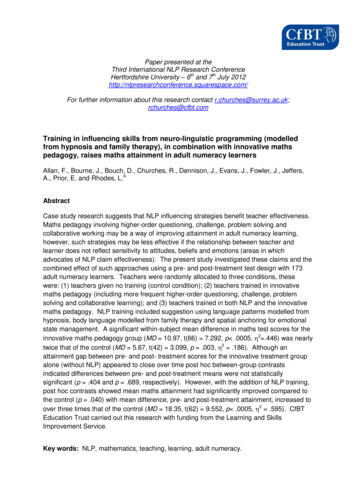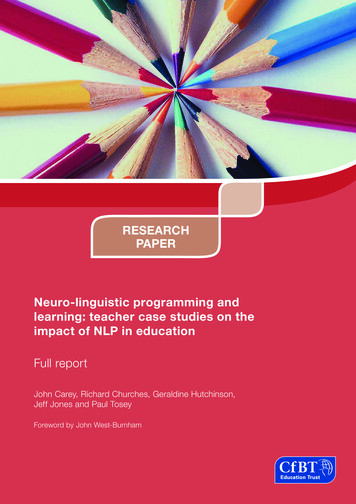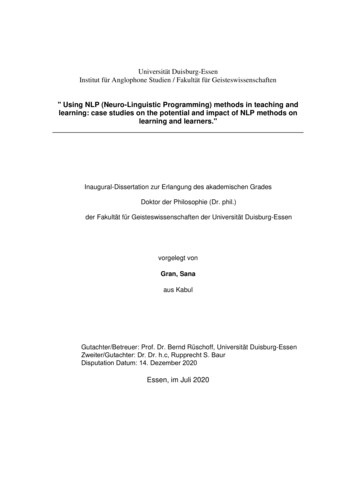
Transcription
Universität Duisburg-EssenInstitut für Anglophone Studien / Fakultät für Geisteswissenschaften" Using NLP (Neuro-Linguistic Programming) methods in teaching andlearning: case studies on the potential and impact of NLP methods onlearning and learners."Inaugural-Dissertation zur Erlangung des akademischen GradesDoktor der Philosophie (Dr. phil.)der Fakultät für Geisteswissenschaften der Universität Duisburg-Essenvorgelegt vonGran, Sanaaus KabulGutachter/Betreuer: Prof. Dr. Bernd Rüschoff, Universität Duisburg-EssenZweiter/Gutachter: Dr. Dr. h.c, Rupprecht S. BaurDisputation Datum: 14. Dezember 2020Essen, im Juli 2020
Diese Dissertation wird via DuEPublico, dem Dokumenten- und Publikationsserver derUniversität Duisburg-Essen, zur Verfügung gestellt und liegt auch als Print-Version z:464-20210531-090438-1Alle Rechte vorbehalten.
1Introduction12Theoretical context; Language acquisition in psychopedagogical approach2.1Current principles of Language Acquisition2.2Cognitive Psychology, Neuroscience, and Second Language Acquisition2.2.1Principles of Cognitive psychology2.2.2The neuro-didactic approach focused on learning process2.3Language teaching theories and the Scientific Basis of Suggestopedia1010161619303Theoretical context; NLP didactical approach3.1What is Neuro-Linguistic Programming (NLP)?3.2Didactic approach of NLP methods3.3Studies observation on NLP3.4Studies linked to use of NLP in SLA.3.5Definition of Rational Emotive Behavior Therapy (REBT)3.5.1Acceptance464651606570834Research questions and Methodology4.1Research Questions4.2The research process4.3Research methods4.4Experiment applied data information4.5Research experiment design8688899094955Case study 1-10 analyses, Survey analyses and results5.1Case Study 15.1.1Language assessment test part 1 results5.1.2Interview transcription analysis5.1.3Neuro-linguistic Programming (NLP) Assessment Test Results5.1.4Rational Emotive Behavior Therapy (REBT) Assessment Test Results5.1.5Language assessment test part 2 results5.1.6Results Comparison of Language assessment 1 and 2.5.2Case Study 25.2.1Language assessment test part 1 results5.2.2Interview transcription analysis5.2.3Neuro-linguistic programming (NLP) Assessments test results5.2.4Rational emotive behavior therapy (REBT) assessment test results5.2.5Language assessment test part 2 results5.2.6Results comparison of language assessment part 1 and 2.5.3Case Study 35.3.1Language assessment test part 1 results5.3.2Interview transcription analysis5.3.3Neuro-linguistic programming (NLP) assessment test results5.3.4Rational Emotive behavior therapy assessment results5.3.5Language assessment test part 2 results5.3.6Results comparison of language assessment part 1 and 166167171174176177
5.4Case Study 45.4.1Language assessment test part 1 results5.4.2Interview transcription analysis5.4.3Neuro-linguistic programming (NLP) assessment test results5.4.4Rational emotive behavior therapy (REBT) assessment test results5.4.5Language assessment test result part 25.4.6Results comparison of language assessment part 1 and 2.5.5Case Study 55.5.1Language assessment test part 1 results5.5.2Interview transcription analysis5.5.3Neuro-linguistic programming (NLP) assessment test results5.5.4Rational emotive behavior therapy (REBT) assessment test results5.5.5Language assessment test results part 25.5.6Results comparison of language assessment part 1 and 2.5.6Case Study 65.6.1Language assessment test part 1 results5.6.2Interview transcription analysis5.6.3Neuro-linguistic programming (NLP) assessment test results5.6.4Rational emotive behavior therapy (REBT) assessment test results5.6.5Language assessment test part 2 results5.6.6Results comparison of language assessment part 1 and 2.5.7Case Study 75.7.1Language assessment test part 1 results5.7.2Interview transcription analysis5.7.3Neuro-linguistic programming (NLP) assessment test results5.7.4Rational emotive behavior therapy (REBT) assessment test results5.7.5Language assessment test part 2 results5.7.6Results comparison of language assessment part 1 and 2.5.8Case Study 85.8.1Language assessment test part 1 results5.8.2Interview transcription analysis5.8.3Neuro-linguistic programming (NLP) assessment test results5.8.4Rational emotive behavior therapy (REBT) assessment test results5.8.5Language assessment test part 2 results5.8.6Results comparison of language assessment part 1 and 2.5.9Case Study 95.9.1Language assessment test part 1 results5.9.2Interview transcription analysis5.9.3Neuro-linguistic programming (NLP) assessment test results5.9.4Rational emotive behavior therapy (REBT) assessment test results5.9.5Language assessment test part 2 results5.9.6Results comparison of language assessment part 1 and 2.5.10 Case Study 105.10.1 language assessment test part 1 0231234236238238239240248250251253254254
5.10.25.10.35.10.45.10.55.10.6Interview transcription resultsNeuro-linguistic programming (NLP) assessment test resultsRational emotive behavior therapy (REBT) assessment test resultsLanguage assessment test part 2 resultsResults comparison of language assessment part 1 and 2.2552642672692706Critical Reflection On Results6.1Neuro-linguistic programming (NLP) test COMPARISON RESULTS of S1-S106.2Language comparison results of S1-S10 based on Exam 1 and Exam 26.3Rational emotive behavior therapy test (REBT) comparison results of S1-S106.4General reflection on the research questions2712712732742767Further research possibilities7.1Personal ideas and suggestions2802818Conclusion2879Plagiarism Declaration28910 References290
Figure 1.1 The brain basis of language processing24Figure 1.2 The Speech Chain38Figure 1.3 Language Input and Output Processing38Figure 1.4 Homework sheet for cognitive therapy42Figure 1.5 Development Stages of Organs in the Human Body45Figure 1.6 and 1.7 Eye Function in Neuro-Linguistic Programming (NLP)55Figure 1.8 Communication Model Neuro-Linguistic Programming (NLP)57
Abbreviations and AcronymsAbbreviationDefinitionAAuditoryABCAction, belief, consequenceCEFRCommon European Framework of Reference for LanguagesCITComprehensive inventory of thrivingDGODependence on General opinionEOEmotional overreactionFMRIFunctional Magnetic Resonance ImagingGAT 2Conversation Analytic Transcription System 2GBGuilt the factor & BlameGGustatoryKKinestheticMRIMagnetic resonance imagingMSMutual SupportNNeutralNLPNeuro linguistic programmingOOlfactoryPEPerfectionismREBTRational emotive behavior therapySLASecond language acquisitionVVisual
Didactic approach: To which extent does Neuro-Linguistic Programming (NLP)methods have the potential to increase the ability of teaching and learning?1 INTRODUCTIONPurposeThe problem stated in this research is finding solutions to develop a methodology thathelps individuals identify irrational beliefs. Additionally, it should provide knowledgeabout the basis of the brain's perception in processing the information. Such informationwould encourage the individual to raise his/her self-esteem and not hesitate whilecorresponding in or articulating in a second language. The predicament condition is toconfront individuals who possess knowledge and expertise but are reluctant aboutapplying such knowledge and expertise at a similar level. Such reluctance is an issue thatis recognized individually. Specifically, such individuals are conscious of the situationthat is causing dissatisfaction. Several research studies by Paul Tosey and Jane Mathison,who work actively in the department of educational studies, have been published. InSeptember 2003, Paul Tosey and Jane Mathison presented a paper at the EuropeanConference on Educational Research in Hamburg. The two discussed the significance ofmore academic research concerning the NLP methods and their implications for teachingand learning. The following text, cited from their findings of the NLP-approach forteaching and learning, as Paul Tosey and Jane Mathison reported in their paper, describeshow NLP methods are used in teaching and learning. See (Tosey & Mathison, 2003b, pp.371–388)"Briefly, they have characterized an NLP approach to teaching and learning as follows: The teacher-learner rapport being a cybernetic loop is a dynamic process throughwhich meaning can be constructed through reciprocal feedback, not through onlytransferring information to learners. People act in accordance with how one understands and represents the world,not the way the world "is" (i.e., "the map is not the territory").1
In NLP, the main area of interest is how people internally represent the worldthrough sensory images (mainly visual, auditory, and kinesthetic) and language.In NLP, one of the main interests is identifying the structure of internalrepresentations, for example, visual images, size and brightness, anddynamically. According to NLP, the internal representation structure hasregularity and is unique for each individual. NLP assumes that there are systematic relationships between the structure of theinternal representation of language and behavior. The internal representations andprocessing of a learner are reflected in different ways in his/her language andexternal behavior, e.g., non-verbal behavior. All skills, beliefs, and behaviors are learned. Sequential patterns of internalrepresentation often referred to as "strategies" x. The process through which suchrepresentations or sequences can be acquired or modified is called learning. The learning ability of an individual is strongly influenced by hisneurophysiological "state" (e.g., a state of curiosity rather than a state ofboredom) and his beliefs about learning and about himself as a learner (ratherobvious are the beliefs that one is capable of learning and that learning isworthwhile and that fun is more useful than their opposites). Such states andbeliefs are also learned and susceptible to change. Such changes are achieved through communication between the teacher and thelearner, both consciously and unconsciously, through both verbal and non-verbalchannels. Each communication has the potential to influence learning. Importantly,teachers' language and behavior affect learners on at least two levelssimultaneously, both understanding the subject matter (e.g., the dynamicstructure of their internal representations) and their beliefs about the world,including learning. Hence, the awareness of the choices made concerning the teachers' language andbehavior patterns and sensitivity to and curiosity about the influence of these2
patterns on and interaction with the internal representations of the learners areessential factors in effective teaching and learning.Mainly, the teaching process involves creating, "states" that are conducive to learning,easing learners to explore or improve their internal representations, achieving a desiredgoal or outcome of the context.” (Tosey & Mathison, 2003a, pp. 371–388)“Neuro-linguistic Programming (NLP), developed in the USA in the 1970’s, hasachieved widespread popularity as a method for communication and personaldevelopment, and is a recognised mode of psychotherapy in the UK. It is also beingapplied widely, if often informally, in UK education. To date, however, the academiccommunity has shown little interest.” It was published in 2003, in which Paul Tosey andJane Mathison discussed the five main concerns of the Craft article (2001) questioningthe NLP methods. There was one point that concerned the " modeling " in NLP methods.As the founder of the NLP, John Grinder states the five Steps of the NLP . (Bandler &Grinder, 1975, pp. 13–27)1. "Finding a genius" More precisely, the term "genius" is not intended to refer to afamous person or a celebrity. It emphasizes a subject's being admired and identified forlearning, e.g., each behavior has its learning origin. The word "genius" is referred to as asubject who was admired or who is being admired.2. Within a specific context of the patterns available by the genius, such as posturesegments, which are known as the assimilation of patterns for unconscious adaptation.3. Practicing in a parallel setting and executing similar patterns associated with the"genius."4. The replication of the selected adaptive behavior. It is also known as coding of theExplicated Model,5. Testing procedure. (Bandler & Grinder, 1975, pp. 13–45)These are the explanations that John Grinder provides for the application use of NLPmodeling. His research focuses on the explanation as well as on the identification ofexperiences that one could gain from the chosen “genius.” To scientifically3
investigate the influence and impact of the genius identifier is recognizable in the fieldof Cognitive psychology, which deals with memories or experiences people haveconstructed as a result, based on their perceptions. Each action and response areconstructed through the pattern that is identified through the events lived during theexperience. However, no evidence can be found which would suggest an individual orchild would be able to learn in the absence of any interaction with its environment. Theemphasis of the research lies on the question of whether this modeling processes in humanbehavior exists in human nature.Paul Tosey and Jane Mathison stated in their article published in August 2010 "NLP - anemerging, controversial approach to communication and personal development createdin the 1970s - has become increasingly familiar in education and teaching. There is littleacademic work on NLP to date". (Tosey & Mathison, 2010, pp. 317–326)They emphasized more academic investigation possibilities and the lack of scientificstudies available so far.This research aims to explain the nature of Neuro-Linguistic Programming (NLP)methods and explore its potential for learning and teaching. The research starts toinvestigate the advancement of human potential in learning diverse languages. Theselection of subjects is in various age classifications. The experiments are designed toanswer the question: is there a scientific explanation of Neuro-Linguistic Programming(NLP) methods used by the metaphysical human nature of individuals?Rational Emotive Behavior Therapy (REBT) was created by Albert Ellis and is used incognitive psychology to treat patients suffering from several irrational thoughts or beliefs.(Ellis, 2001a, pp. 79–103) Combining both NLP and REBT methods will educate thesubjects to apply the NLP techniques effectively. The combination of both methods isdesigned to learn how to enhance self-esteem and improve sensory perception. REBTmethods are designed for understanding the rationale or irrational thinking processes ofindividual thoughts. The change processes have to happen by the decision they couldchoose for themselves. Although knowledge is passed to them, it is obviously up to themto use the instruction or decide otherwise. Most of the companies post their codes ofethics and conduct on their websites and provide all employees access. This is the4
individual decision of the employees to comply with the code of ethics or code ofconduct. Clearly, the penalty for non-compliance with the 'Code of Ethics' or 'Code ofConduct' can be justified as a consequence for the employees. The application of NLPmethods is not imposed with any consequences for practitioners. Uses of NLPmethodologies are not prohibited; neither are their legal consequences for practitioners orpeople attending NLP seminars. This research is focused on providing clear explanationsabout the methods, with no manipulation or any formal implications for the practitioners.All subjects voluntarily participate in this research. NLP is applied in Sales, Marketing,and Management; it is essential to apply and use NLP as an educational tool.These experimental research findings might contribute to the enhancement of the learningabilities of the individuals. There are several studies which exceed the educationalapproach of teachers. This study aims to find methods that improve the learning expertiseof individuals. Implementing NLP and rational emotive behavior therapy (REBT) is anon-conventional approach as evidence has shown that Psychology and Linguistics arecombined fields of similar to the “Suggestopedic” approach. Rupprecht S. Baur hascoined the term “psychopedia” and has strongly suggested the effectiveness ofSuggestopadic learning and teaching style. (Baur, 1991, p. 11) The study aims to givealternative suggestions regarding the affective filter of language teaching and learning.This paper might contribute to future research and impact on the learning behavior ofstudents. As well as finding adequate learning methods, this paper will examine whetherindividuals instinctively utilize NLP methods during early stages of perception. If so, doNLP methods enhance one’s learning ability?It is relevant for the research conducted in this study that the subjects are trained inapplying the NLP principles by themselves. However, the use of the NLP methodologyand REBT methodologies can be combined with each other to investigate the effect ofNLP on subjects and explore the results. Awareness about our own representationalsystem and sensory abilities is the essential factor when teaching the subjects. While thesubjects are learning the second language and are trying to enhance personal sensoryperceptions, they will be asked to be creative in freely choosing their preferred wayof learning a second language, e.g., through reading, by listening to the radio or by5
watching a movie. The language that is absorbed through all sources was highlyconsidered as a result of implementing knowledge about selective sensory awarenesssuch as auditory people may prefer to hear music and study voice; visual people mayprefer watching films to enhance language fluency - this might vary from one case to theother. The investigation focuses on the individuals applying the NLP methods onthemselves might enhance and improve their abilities or not. Following guidance on andclarification of the NLP methods, it is concluded that the research not only highlightsapplications of the NLP methods but also demonstrates a demand to combine the REBTmethods in order, for the purpose as a whole, to increase both learning as well aseducational opportunities. Combining the REBT with NLP will be the approach appliedin this project. The most fundamental part of this research is the rational reasoningprocess. The study participants not only focus on improving their English skills but alsoattempted to resolve their hesitation when using the English language. This study aims toteach rational thinking to university students and adults working in companies. Ifeverybody can identify their rational beliefs, then this could enhance their educationalperformance. To generate discourse about rationality, it is crucial to understand REBT.Rational thoughts increase a human’s positive potential of performance and irrationalthoughts decrease human’s potential for achievement. This method is not restricted to aparticular group but for every individual who is seeking to be educated. Everybody willhave the opportunity to identify rational thinking regardless of his or her color of skin,gender, ethnicity, race, religion, and nationality. Mutual understanding is crucial for bothparties. Therefore, it is essential that both teachers and students practice methods that canenhance their performance.ParticipantsThe subjects 1-10 are employed persons in various professions: working in companiesbased in Germany. The age of the subjects ranges from 23 to 55 years. Language testspart 1 will be conducted for the assessment to determine their language level. Theinterviews will be conducted to investigate specific issues. Two psychological6
assessments, which are based on NLP and REBT questionnaires, will be offered. Theseresults are then presented to the subjects to enable them to compute the outcome.Afterwards the subjects will participate in the language assessment tests Part 2.Research processTo begin with, all the subjects would write an English language assessment test. The datawill be provided to the subjects in the form of a printout, and they will complete thedocuments in my presence. Face-to-face interviews are conducted and recorded, and thetranscript is provided in the appendix. - After carefully conducting interviews with thesubjects and the questions and answers will help me to identify the factors that havecaused the level of anxiety and dissatisfaction in using SLA. Each case is treateddifferently and during this experiment, there is no way to transfer the information fromone case to another. Each subject is an adult with different language levels and differentexperiences with SLA.After completing the interview, NLP questionnaires are first distributed to all subjects,which they are asked to complete and submit. After that, a schedule for the seminar is set,focusing on NLP basics emphasizing how sensory perception works to enhance theprocessing of information in the brain. After the seminar, the REBT questionnaires aredistributed to the subjects; once the subjects answered the REBT questions, thesedocuments of the REBT study's questionnaires are submitted to me and are available inthe appendix. After the REBT questionnaires are answered, the REBT seminar isscheduled, where the focus is on the application of the ABC therapy model. Subsequently,the final appointment is scheduled with the subjects, during which the second languageassessment test is conducted, and the data is collected. In this experiment, the main focusis on reducing anxiety level, and other factors could also influence the languageimprovement since the subjects were not in quarantine observation.7
Task designFirst of all, all the subjects will receive a letter of written consent that they will bevoluntarily requested to sign in case of acceptance. The experiment will be processed viavoice recording, questionnaires, and interviews. In all cases, the test persons take anassessment language examination in English; in addition, the interviews will beconducted with the transcription according to (GAT2). Subsequently, both NLP andREBT surveys will be conducted according to the "comprehensive inventory of thriving"(CIT) measures used in the field of Psychology. After completing these tests, answers areprovided to the participants. The second assessment examination is then held. After thecompletion of the processes, the results of both examinations will be compared for eachcase study. The results of NLP and REBT surveys will be presented, and in the end, allof the data will be summarized and examined.Five rounds of the research processesIn the first round of case studies, ten employees who take part in English-languageseminars are studied. Such employees will have various professional positions in differentGerman companies. All of the subjects will participate in the first English languageassessment test. The results from the tests will then be evaluated for each participant.Second round: the "modeling" system of NLP will be explored by conducting a feedbacktest to show the "modeling" process of the internal mind map of adults. Interviews willbe held with every subject. The subjects will be asked to speak about their educationalexperiences, both excellent and unsatisfactory ones. The test persons are in various agegroups and have different degrees and qualifications. Interviews will be held withquestions on their educational experiences.Third round: the test persons will receive further questionnaires, including an assessmentquestionnaire on the methods of NLP focused on sensory perception. This assessment testincludes identifying the perceptual sensors and the intelligence mechanisms involvedwhen using NLP. At the start of each case study, subjects are unaware of the methodsused by NLP. They are only taught about the NLP methods after answering the8
assessment questionnaires. The NLP assessment test will be provided with the answersto the evaluation criteria. Then the results will be presented to the subjects to enablethem to evaluate their results.Fourth round: The emphasis here is on investigating these two aspects of the question tobe answered by this study group. Are their irrational beliefs restricting their learningability concerning their educational performance? On the other hand, do their rationalbeliefs increase their potential for educational success? Questionnaires will be developedbased on REBT rational emotive behavior therapy. The data will be provided to themabout rational as well as irrational beliefs. They will start self-education by determiningtheir attitudes regarding their behavior. Results are then presented to subjects to allowthem to compute the outcomes. These surveys are intended, in particular, to help thesubjects to be more conscious about their attitude and behavior while learning the Englishlanguage. It will also enable them to discover their approaches towards their behavior.Fifth round: the subjects take part in the second English-language assessment test. Boththe first and second English language tests will be evaluated, and the results obtained inboth tests are then compared to determine the outcome of the tests by measuring theresults.9
2 THEORETICAL CONTEXT; LANGUAGE ACQUISITION INPSYCHOPEDAGOGICAL APPROACH2.1 CURRENT PRINCIPLES OF LANGUAGE ACQUISITIONSeveral psychologists, neuroscientists, and linguists worked and described their interestin psycho-pedagogical concepts to understand the complexity of language acquisition andproduction. Specifically, the psychologists presented several examples that illustratedvarious approaches that have contributed to the discovery, outlining numerous techniquesfor enhancing the language learning processes. Stephen Krashen is a psychologist whodeveloped a theory in the 1980s. (Krashen, 1982, pp. 30–59) His theory of secondlanguage acquisition consists of five main hypotheses: the Acquisition-Learning hypothesis; the Monitor hypothesis; the Input hypothesis; the Affective Filter hypothesis; the Natural Order hypothesis;Krashen describes the difference between Acquisition and Learning. The "Acquisition"is described by Krashen's as a subconscious state of mind while learning the secondlanguage. That means that adults and children are capable of the subconscious learningof language. Adults and children require "meaningful interaction" during the educationalprocessing of language. The "Learning" is described as a conscious state of mind whilelearning. That means that by being aware of rules and grammar, as language learningrequires, may result in the conscious awareness of language processing. The MonitorHypothesis describes the connection between Acquisition and Learning. Krashen statesthat when individuals focus on the construction of grammar, they focus more on the formrather than the meaning, which may result in less exchange of information. Thecorrelation between Acquisition Learning may result in a focus on correctnessrather than production. Therefore, monitoring is useful in written languagecorrespondence more than in communication. The input hypothesis is that the focus10
of the learner should be first on meaning and then on structure. The Second languageacquisition (SLA) should be more focused on meaning first and grammar later. Theaffective filter hypothesis illustrates that a number of variables are facilitative, but play anon-causal role in SLA. Variables such as motivation, self-esteem, anxieties are relevanthere. Low motivation, low self-esteem can raise the anxiety level and causes a mentalblock that prevents comprehensible input from being used for acquisition. Greatconfidence and high self-esteem will help the individual to improve the reproduction oflanguage. The natural hypothesis is that the grammatical structure is predictable, andmorphology is the most studied part of a language.“It seems reasonable to hypothesize that the classroom should be especially valuable forbeginners, those who cannot easily utilize the informal environment for input. It will beof less value to those who can, who have other sources of comprehensible input, andwho are linguistically advanced enough to take advantage of it.The question then does not become "Does language teaching help?" but"When does language teaching help?". A possible answer is this: language teaching helpswhen it is the main source of low filter comprehensible input, that is, for beginners andfor foreign language students who do not have a chance to get input outside the class. Itwill be of less help when rich sources of input are available. If the research literaturesupports these generalizations, it confirms the generalization that language teaching helpssecond language acquisition when it supplies comprehensible input, which is the truecause of second language acquisition”. (Krashen, 1982, p. 32)Specifically, for example when teaching language to beginners, as Krashen's work states,the level of input should be increased; however, the subjects participating in this researchare not beginners, hence it is appropriate to use methods that will decrease anxiety levelswhile increasing self-esteem levels for the purpose of enhancing their desiredperformance of language.The factors identified by Krashen play a large role in the production of SLA use. Itis clear and supported by several studies that factors such as anxiety lowers, self11
esteem causes hesitation in production. In the neuroscience field, the researchers haveproved that anxiety can reduce the degree of learning achievement.“Aus eigener Erfahrung können die meisten Menschen bestätigen, dass positiveEmotionen beim Lernen förderlich wirken. Man fühlt sich kompetent, genau im richtigenMaße herausgefordert, ist an der Thematik oder Auf
“Neuro-linguistic Programming (NLP), developed in the USA in the 1970’s, has achieved widespread popularity as a method for communication and personal development, and is a recognised mode of psychotherapy in the UK. It is also being applied widely, if often in
